Flink是Apache软件基金会下开源的分布式流批一体计算框架,具备实时流计算和高吞吐批处理计算的大数据计算能力。本专栏内容为Flink源码解析的记录与分享。
本文解析的Kafka源码版本为:flink-1.19.0
1.Flink集群端调度概述
在前文 《Flink-1.19.0源码详解5-JobGraph生成-前篇》和《Flink-1.19.0源码详解6-JobGraph生成-后篇》中,已介绍了Flink JobGraph生成的源码,解析了Flink遍历StreamGraph的每个StreamNode节点,逐步生成JobVertex节点、JobEdge边和IntermediateDataSet数据集,逐步构建JobGraph图的完整过程。在完成 JobGraph的生成后,Flink Client会向Yarn中的Flink集群提交调度请求与JobGraph,完成调度从客户端到集群端的转变。
本文从Flink集群接收Flink客户端请求开始,解析Flink集群端的调度(内容为下流程图的红色部分)。解析Flink集群Dispatcher接收了来自CliFrontend客户端发送的Request,从HDFS文件系统拉取JobGraph文件、Jar包和Artifacts依赖 ,创建并启动JobMaster开启Flink的集群端调度。

完整代码解析:

2.Dispatcher接收了CliFrontend客户端发送的Request
当Flink客户端完成JobGraph生成与客户端调度后,Flink CliFrontend客户端会向Yarn中的Flink集群发送调度请求,向Hdfs文件系统上传了JobGraph文件、Jar包和Artifacts依赖。Flink集群的Dispatcher接收到客户端请求后,开始进行Flink集群端调度。
源码图解:

DispatcherRestEndpoint接收到RestClient的JobSubmit请求,会调用JobSubmitHandler的handleRequest()方法处理请求。
JobSubmitHandler接收了客户端发送JobSubmitRequestBody请求体,获取JobGraph、jar、artifacts,并向Dispatcher(DispatcherGateway)提交了JobGraph。
JobSubmitHandler的handleRequest()方法源码:
protected CompletableFuture<JobSubmitResponseBody> handleRequest(
@Nonnull HandlerRequest<JobSubmitRequestBody> request,
@Nonnull DispatcherGateway gateway)
throws RestHandlerException {
//获取上传的文件信息
final Collection<File> uploadedFiles = request.getUploadedFiles();
final Map<String, Path> nameToFile =
uploadedFiles.stream()
.collect(Collectors.toMap(File::getName, Path::fromLocalFile));
//...
//获取jobSubmit的请求体
final JobSubmitRequestBody requestBody = request.getRequestBody();
if (requestBody.jobGraphFileName == null) {
throw new RestHandlerException(
String.format(
"The %s field must not be omitted or be null.",
JobSubmitRequestBody.FIELD_NAME_JOB_GRAPH),
HttpResponseStatus.BAD_REQUEST);
}
//获取JobGraph、jar、artifacts
CompletableFuture<JobGraph> jobGraphFuture = loadJobGraph(requestBody, nameToFile);
Collection<Path> jarFiles = getJarFilesToUpload(requestBody.jarFileNames, nameToFile);
Collection<Tuple2<String, Path>> artifacts =
getArtifactFilesToUpload(requestBody.artifactFileNames, nameToFile);
CompletableFuture<JobGraph> finalizedJobGraphFuture =
uploadJobGraphFiles(gateway, jobGraphFuture, jarFiles, artifacts, configuration);
//向Dispatcher(DispatcherGateway)提交JobGraph
CompletableFuture<Acknowledge> jobSubmissionFuture =
finalizedJobGraphFuture.thenCompose(
jobGraph -> gateway.submitJob(jobGraph, timeout));
return jobSubmissionFuture.thenCombine(
jobGraphFuture,
(ack, jobGraph) -> new JobSubmitResponseBody("/jobs/" + jobGraph.getJobID()));
}执行gateway.submitJob()时,由实现DispatcherGateway接口的Dispatcher执行submitJob()方法 。Dispatcher又经过下面多次调用,进入JobMaster启动。
Dispatcher.submitJob()方法源码:
//继续调用
internalSubmitJob(jobGraph);Dispatcher.internalSubmitJob()方法源码:
//继续调用
waitForTerminatingJob(jobGraph.getJobID(),
jobGraph, this::persistAndRunJob)Dispatcher.internalSubmitJob()方法调用了Dispatcher.persistAndRunJob()方法进行JobMaster创建。
3.Dispatcher创建JobMasterServiceLeadership
在Dispatcher.persistAndRunJob()方法中,Dispatcher先执行createJobMasterRunner()方法创建了JobMasterServiceLeadership (RunnerJobManagerRunner接口的实现),再执行Dispatcher.runJob()方法启动JobMasterServiceLeadership。
Dispatcher.persistAndRunJob()方法源码:
private void persistAndRunJob(JobGraph jobGraph) throws Exception {
jobGraphWriter.putJobGraph(jobGraph);
initJobClientExpiredTime(jobGraph);
//先调用createJobMasterRunner(),再执行runJob()
runJob(createJobMasterRunner(jobGraph), ExecutionType.SUBMISSION);
}在Dispatcher.createJobMasterRunner()方法中,Dispatcher通过JobManagerRunnerFactory创建了JobMasterServiceLeadership实例(RunnerJobManagerRunner接口的实现)。
Dispatcher.createJobMasterRunner()方法源码:
private JobManagerRunner createJobMasterRunner(JobGraph jobGraph) throws Exception {
Preconditions.checkState(!jobManagerRunnerRegistry.isRegistered(jobGraph.getJobID()));
//创建JobMasterServiceLeadership
return jobManagerRunnerFactory.createJobManagerRunner(
jobGraph,
configuration,
getRpcService(),
highAvailabilityServices,
heartbeatServices,
jobManagerSharedServices,
new DefaultJobManagerJobMetricGroupFactory(jobManagerMetricGroup),
fatalErrorHandler,
failureEnrichers,
System.currentTimeMillis());
}在Dispatcher.runJob()方法则启动了JobMasterServiceLeadership。
Dispatcher.runJob()方法源码:
private void runJob(JobManagerRunner jobManagerRunner, ExecutionType executionType)
throws Exception {
//启动JobMasterServiceLeadership
jobManagerRunner.start();
//...
}4.JobMasterServiceLeadership启动并启动JobMaster
JobMasterServiceLeadership需要走一遍Flink的选举流程,然后启动JobMaster,由于选举流程经历了大量封装和调用,具体解析见下图的源码图解。
源码图解:
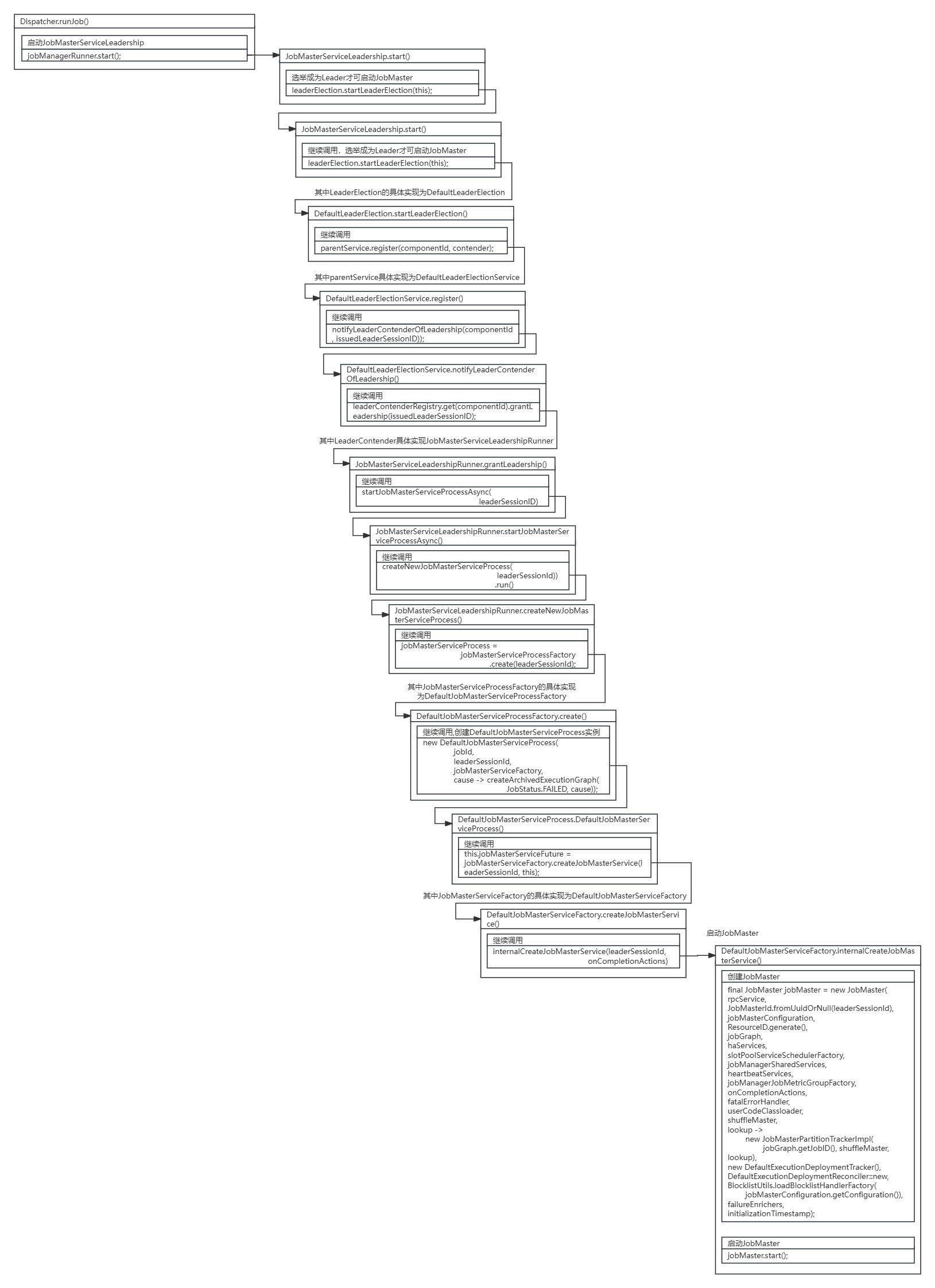
最终由DefaultJobMasterServiceFactory的internalCreateJobMasterService()方法创建并启动JobMaster实例。
DefaultJobMasterServiceFactory.internalCreateJobMasterService()方法源码:
private JobMasterService internalCreateJobMasterService(
UUID leaderSessionId, OnCompletionActions onCompletionActions) throws Exception {
//创建JobMaster实例
final JobMaster jobMaster =
new JobMaster(
rpcService,
JobMasterId.fromUuidOrNull(leaderSessionId),
jobMasterConfiguration,
ResourceID.generate(),
jobGraph,
haServices,
slotPoolServiceSchedulerFactory,
jobManagerSharedServices,
heartbeatServices,
jobManagerJobMetricGroupFactory,
onCompletionActions,
fatalErrorHandler,
userCodeClassloader,
shuffleMaster,
lookup ->
new JobMasterPartitionTrackerImpl(
jobGraph.getJobID(), shuffleMaster, lookup),
new DefaultExecutionDeploymentTracker(),
DefaultExecutionDeploymentReconciler::new,
BlocklistUtils.loadBlocklistHandlerFactory(
jobMasterConfiguration.getConfiguration()),
failureEnrichers,
initializationTimestamp);
//启动JobMaster
jobMaster.start();
return jobMaster;
}5.JobMaster创建
DefaultJobMasterServiceFactory的internalCreateJobMasterService()方法创建了JobMaster实例。
//创建JobMaster实例
final JobMaster jobMaster =
new JobMaster(
rpcService,
JobMasterId.fromUuidOrNull(leaderSessionId),
jobMasterConfiguration,
ResourceID.generate(),
jobGraph,
haServices,
slotPoolServiceSchedulerFactory,
jobManagerSharedServices,
heartbeatServices,
jobManagerJobMetricGroupFactory,
onCompletionActions,
fatalErrorHandler,
userCodeClassloader,
shuffleMaster,
lookup ->
new JobMasterPartitionTrackerImpl(
jobGraph.getJobID(), shuffleMaster, lookup),
new DefaultExecutionDeploymentTracker(),
DefaultExecutionDeploymentReconciler::new,
BlocklistUtils.loadBlocklistHandlerFactory(
jobMasterConfiguration.getConfiguration()),
failureEnrichers,
initializationTimestamp);源码图解:
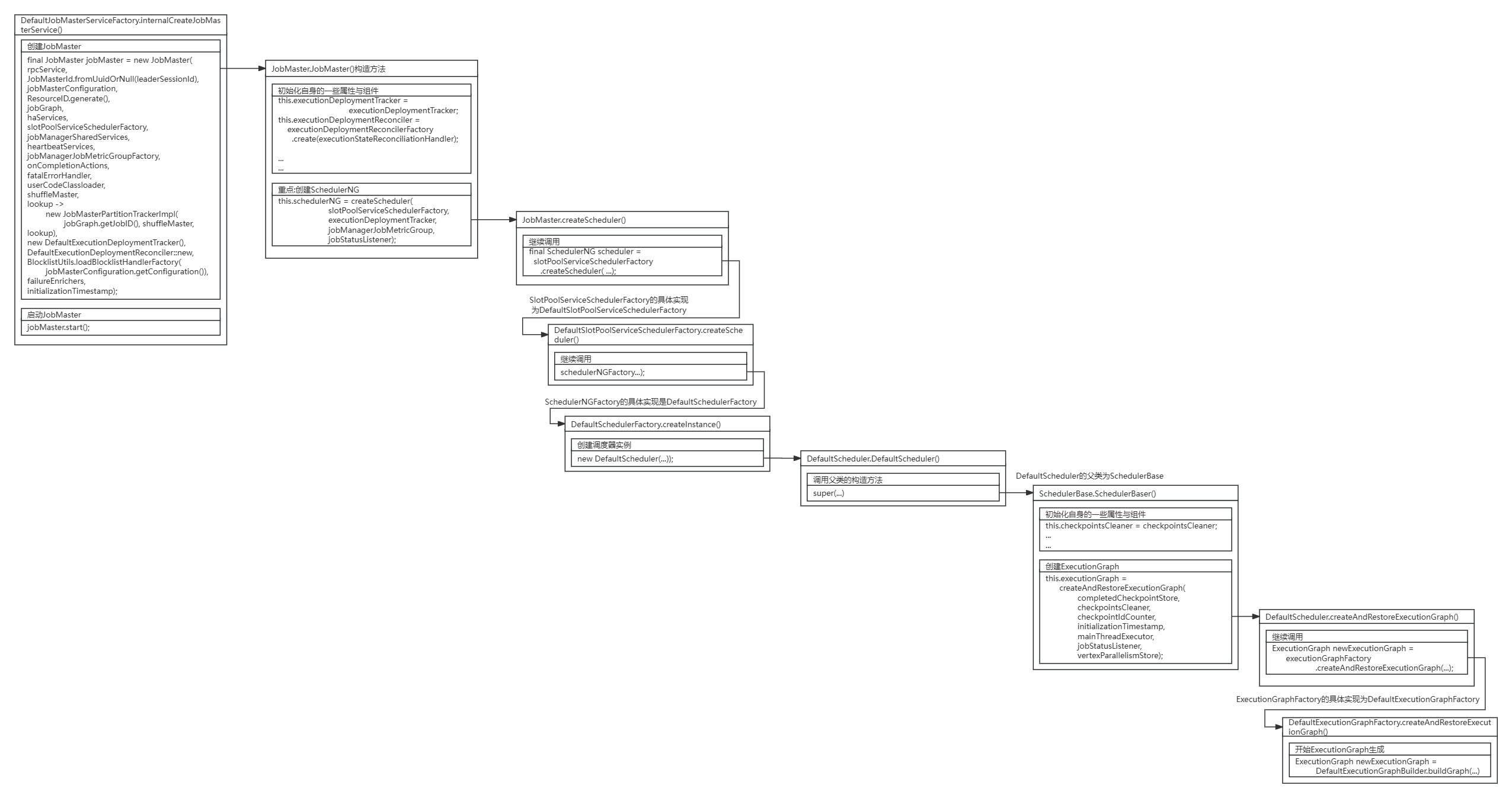
首先进入JobMaster的构造方法,JobMaster的构造方法初始化了自身的一些属性与组件,重点关注SchedulerNG的创建。
JobMaster.JobMaster()构造方法源码:
public JobMaster(
RpcService rpcService,
JobMasterId jobMasterId,
JobMasterConfiguration jobMasterConfiguration,
ResourceID resourceId,
JobGraph jobGraph,
HighAvailabilityServices highAvailabilityService,
SlotPoolServiceSchedulerFactory slotPoolServiceSchedulerFactory,
JobManagerSharedServices jobManagerSharedServices,
HeartbeatServices heartbeatServices,
JobManagerJobMetricGroupFactory jobMetricGroupFactory,
OnCompletionActions jobCompletionActions,
FatalErrorHandler fatalErrorHandler,
ClassLoader userCodeLoader,
ShuffleMaster<?> shuffleMaster,
PartitionTrackerFactory partitionTrackerFactory,
ExecutionDeploymentTracker executionDeploymentTracker,
ExecutionDeploymentReconciler.Factory executionDeploymentReconcilerFactory,
BlocklistHandler.Factory blocklistHandlerFactory,
Collection<FailureEnricher> failureEnrichers,
long initializationTimestamp)
throws Exception {
super(rpcService, RpcServiceUtils.createRandomName(JOB_MANAGER_NAME), jobMasterId);
final ExecutionDeploymentReconciliationHandler executionStateReconciliationHandler =
new ExecutionDeploymentReconciliationHandler() {
@Override
public void onMissingDeploymentsOf(
Collection<ExecutionAttemptID> executionAttemptIds, ResourceID host) {
log.debug(
"Failing deployments {} due to no longer being deployed.",
executionAttemptIds);
for (ExecutionAttemptID executionAttemptId : executionAttemptIds) {
schedulerNG.updateTaskExecutionState(
new TaskExecutionState(
executionAttemptId,
ExecutionState.FAILED,
new FlinkException(
String.format(
"Execution %s is unexpectedly no longer running on task executor %s.",
executionAttemptId, host))));
}
}
@Override
public void onUnknownDeploymentsOf(
Collection<ExecutionAttemptID> executionAttemptIds, ResourceID host) {
log.debug(
"Canceling left-over deployments {} on task executor {}.",
executionAttemptIds,
host);
for (ExecutionAttemptID executionAttemptId : executionAttemptIds) {
TaskManagerRegistration taskManagerRegistration =
registeredTaskManagers.get(host);
if (taskManagerRegistration != null) {
taskManagerRegistration
.getTaskExecutorGateway()
.cancelTask(executionAttemptId, rpcTimeout);
}
}
}
};
//初始化自身的一些属性与组件
this.executionDeploymentTracker = executionDeploymentTracker;
this.executionDeploymentReconciler =
executionDeploymentReconcilerFactory.create(executionStateReconciliationHandler);
this.jobMasterConfiguration = checkNotNull(jobMasterConfiguration);
this.resourceId = checkNotNull(resourceId);
this.jobGraph = checkNotNull(jobGraph);
this.rpcTimeout = jobMasterConfiguration.getRpcTimeout();
this.highAvailabilityServices = checkNotNull(highAvailabilityService);
this.blobWriter = jobManagerSharedServices.getBlobWriter();
this.futureExecutor = jobManagerSharedServices.getFutureExecutor();
this.ioExecutor = jobManagerSharedServices.getIoExecutor();
this.jobCompletionActions = checkNotNull(jobCompletionActions);
this.fatalErrorHandler = checkNotNull(fatalErrorHandler);
this.userCodeLoader = checkNotNull(userCodeLoader);
this.initializationTimestamp = initializationTimestamp;
this.retrieveTaskManagerHostName =
jobMasterConfiguration
.getConfiguration()
.get(JobManagerOptions.RETRIEVE_TASK_MANAGER_HOSTNAME);
final String jobName = jobGraph.getName();
final JobID jid = jobGraph.getJobID();
log.info("Initializing job '{}' ({}).", jobName, jid);
resourceManagerLeaderRetriever =
highAvailabilityServices.getResourceManagerLeaderRetriever();
this.registeredTaskManagers = new HashMap<>();
this.blocklistHandler =
blocklistHandlerFactory.create(
new JobMasterBlocklistContext(),
this::getNodeIdOfTaskManager,
getMainThreadExecutor(),
log);
this.slotPoolService =
checkNotNull(slotPoolServiceSchedulerFactory)
.createSlotPoolService(
jid,
createDeclarativeSlotPoolFactory(
jobMasterConfiguration.getConfiguration()));
this.partitionTracker =
checkNotNull(partitionTrackerFactory)
.create(
resourceID -> {
return Optional.ofNullable(
registeredTaskManagers.get(resourceID))
.map(TaskManagerRegistration::getTaskExecutorGateway);
});
this.shuffleMaster = checkNotNull(shuffleMaster);
this.jobManagerJobMetricGroup = jobMetricGroupFactory.create(jobGraph);
this.jobStatusListener = new JobManagerJobStatusListener();
this.failureEnrichers = checkNotNull(failureEnrichers);
//重点:创建SchedulerNG
this.schedulerNG =
createScheduler(
slotPoolServiceSchedulerFactory,
executionDeploymentTracker,
jobManagerJobMetricGroup,
jobStatusListener);
this.heartbeatServices = checkNotNull(heartbeatServices);
this.taskManagerHeartbeatManager = NoOpHeartbeatManager.getInstance();
this.resourceManagerHeartbeatManager = NoOpHeartbeatManager.getInstance();
this.resourceManagerConnection = null;
this.establishedResourceManagerConnection = null;
this.accumulators = new HashMap<>();
}执行JobMaster.createScheduler()方法创建SchedulerNG后,又经过下图一系列调用,最终执行到SchedulerBase.SchedulerBase()构造方法。
源码图解:
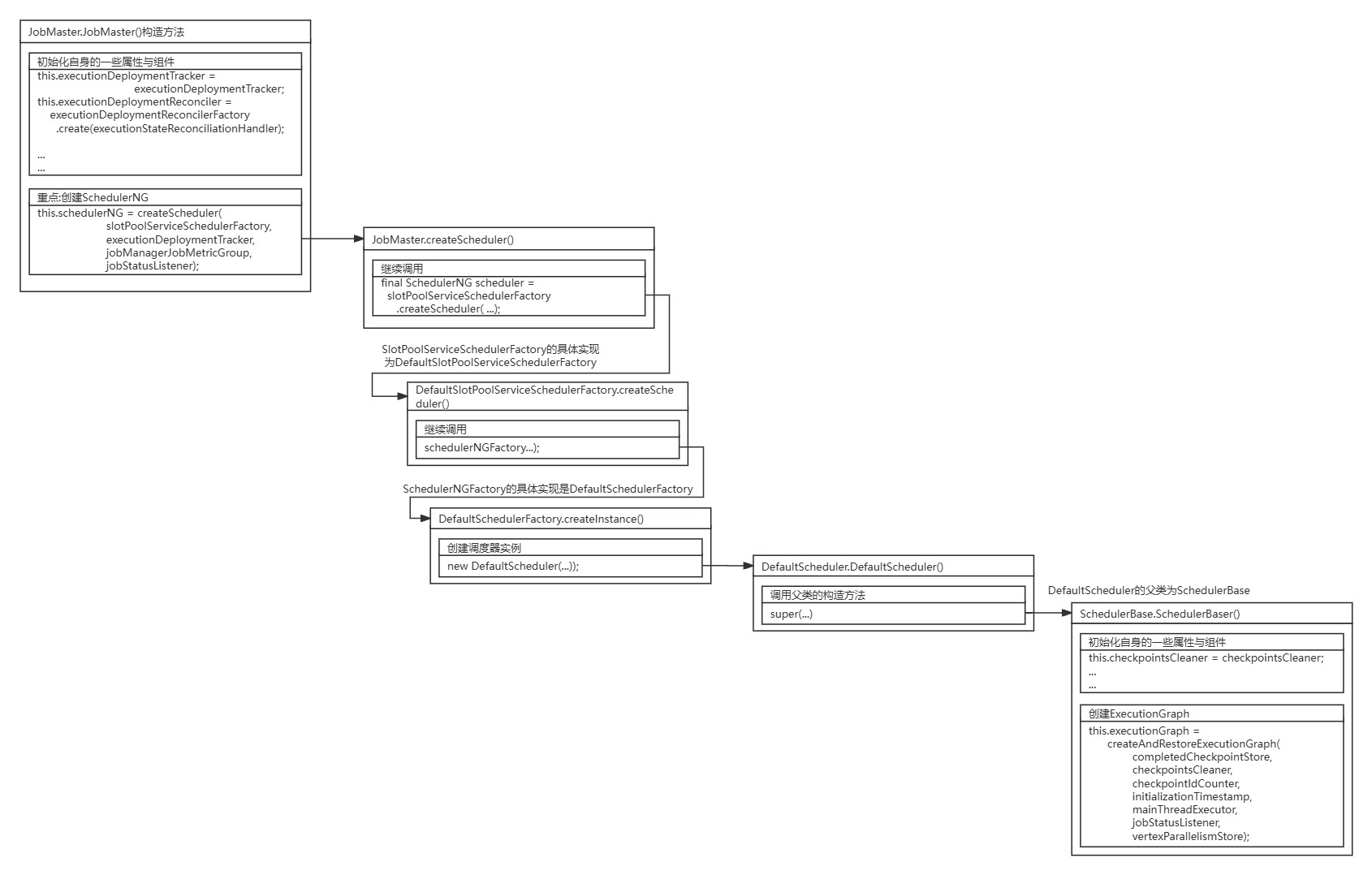
SchedulerBase的构造方法通过createAndRestoreExecutionGraph()方法进行ExecutionGraph的创建。
SchedulerBase.SchedulerBase()构造方法源码:
public SchedulerBase(
final Logger log,
final JobGraph jobGraph,
final Executor ioExecutor,
final Configuration jobMasterConfiguration,
final CheckpointsCleaner checkpointsCleaner,
final CheckpointRecoveryFactory checkpointRecoveryFactory,
final JobManagerJobMetricGroup jobManagerJobMetricGroup,
final ExecutionVertexVersioner executionVertexVersioner,
long initializationTimestamp,
final ComponentMainThreadExecutor mainThreadExecutor,
final JobStatusListener jobStatusListener,
final ExecutionGraphFactory executionGraphFactory,
final VertexParallelismStore vertexParallelismStore)
throws Exception {
this.log = checkNotNull(log);
this.jobGraph = checkNotNull(jobGraph);
this.jobInfo = new JobInfoImpl(jobGraph.getJobID(), jobGraph.getName());
this.executionGraphFactory = executionGraphFactory;
this.jobManagerJobMetricGroup = checkNotNull(jobManagerJobMetricGroup);
this.executionVertexVersioner = checkNotNull(executionVertexVersioner);
this.mainThreadExecutor = mainThreadExecutor;
this.checkpointsCleaner = checkpointsCleaner;
this.completedCheckpointStore =
SchedulerUtils.createCompletedCheckpointStoreIfCheckpointingIsEnabled(
jobGraph,
jobMasterConfiguration,
checkNotNull(checkpointRecoveryFactory),
ioExecutor,
log);
this.checkpointIdCounter =
SchedulerUtils.createCheckpointIDCounterIfCheckpointingIsEnabled(
jobGraph, checkNotNull(checkpointRecoveryFactory));
this.jobStatusMetricsSettings =
MetricOptions.JobStatusMetricsSettings.fromConfiguration(jobMasterConfiguration);
this.deploymentStateTimeMetrics =
new DeploymentStateTimeMetrics(jobGraph.getJobType(), jobStatusMetricsSettings);
//创建ExecutionGraph
this.executionGraph =
createAndRestoreExecutionGraph(
completedCheckpointStore,
checkpointsCleaner,
checkpointIdCounter,
initializationTimestamp,
mainThreadExecutor,
jobStatusListener,
vertexParallelismStore);
this.schedulingTopology = executionGraph.getSchedulingTopology();
stateLocationRetriever =
executionVertexId ->
getExecutionVertex(executionVertexId).getPreferredLocationBasedOnState();
inputsLocationsRetriever =
new ExecutionGraphToInputsLocationsRetrieverAdapter(executionGraph);
this.kvStateHandler = new KvStateHandler(executionGraph);
this.executionGraphHandler =
new ExecutionGraphHandler(executionGraph, log, ioExecutor, this.mainThreadExecutor);
this.operatorCoordinatorHandler =
new DefaultOperatorCoordinatorHandler(executionGraph, this::handleGlobalFailure);
operatorCoordinatorHandler.initializeOperatorCoordinators(this.mainThreadExecutor);
this.exceptionHistory =
new BoundedFIFOQueue<>(
jobMasterConfiguration.get(WebOptions.MAX_EXCEPTION_HISTORY_SIZE));
this.vertexEndOfDataListener = new VertexEndOfDataListener(executionGraph);
}SchedulerBase.createAndRestoreExecutionGraph()方法为ExecutionGraph创建的入口。
源码图解:

SchedulerBase又通过ExecutionGraphFactory进行ExecutionGraph创建。
SchedulerBase.createAndRestoreExecutionGraph()方法源码:
private ExecutionGraph createAndRestoreExecutionGraph(
CompletedCheckpointStore completedCheckpointStore,
CheckpointsCleaner checkpointsCleaner,
CheckpointIDCounter checkpointIdCounter,
long initializationTimestamp,
ComponentMainThreadExecutor mainThreadExecutor,
JobStatusListener jobStatusListener,
VertexParallelismStore vertexParallelismStore)
throws Exception {
//通过executionGraphFactory创建ExecutionGraph
final ExecutionGraph newExecutionGraph =
executionGraphFactory.createAndRestoreExecutionGraph(
jobGraph,
completedCheckpointStore,
checkpointsCleaner,
checkpointIdCounter,
TaskDeploymentDescriptorFactory.PartitionLocationConstraint.fromJobType(
jobGraph.getJobType()),
initializationTimestamp,
new DefaultVertexAttemptNumberStore(),
vertexParallelismStore,
deploymentStateTimeMetrics,
getMarkPartitionFinishedStrategy(),
log);
newExecutionGraph.setInternalTaskFailuresListener(
new UpdateSchedulerNgOnInternalFailuresListener(this));
newExecutionGraph.registerJobStatusListener(jobStatusListener);
newExecutionGraph.start(mainThreadExecutor);
return newExecutionGraph;
}ExecutionGraphFactory的实现为DefaultExecutionGraphFactory,进入DefaultExecutionGraphFactory的createAndRestoreExecutionGraph()方法。
DefaultExecutionGraphFactory.createAndRestoreExecutionGraph()方法源码:
public ExecutionGraph createAndRestoreExecutionGraph(
JobGraph jobGraph,
CompletedCheckpointStore completedCheckpointStore,
CheckpointsCleaner checkpointsCleaner,
CheckpointIDCounter checkpointIdCounter,
TaskDeploymentDescriptorFactory.PartitionLocationConstraint partitionLocationConstraint,
long initializationTimestamp,
VertexAttemptNumberStore vertexAttemptNumberStore,
VertexParallelismStore vertexParallelismStore,
ExecutionStateUpdateListener executionStateUpdateListener,
MarkPartitionFinishedStrategy markPartitionFinishedStrategy,
Logger log)
throws Exception {
ExecutionDeploymentListener executionDeploymentListener =
new ExecutionDeploymentTrackerDeploymentListenerAdapter(executionDeploymentTracker);
ExecutionStateUpdateListener combinedExecutionStateUpdateListener =
(execution, previousState, newState) -> {
executionStateUpdateListener.onStateUpdate(execution, previousState, newState);
if (newState.isTerminal()) {
executionDeploymentTracker.stopTrackingDeploymentOf(execution);
}
};
int totalNumberOfSubTasks =
StreamSupport.stream(jobGraph.getVertices().spliterator(), false)
.mapToInt(
jobVertex ->
vertexParallelismStore
.getParallelismInfo(jobVertex.getID())
.getParallelism())
.sum();
final ExecutionGraph newExecutionGraph =
DefaultExecutionGraphBuilder.buildGraph(
jobGraph,
configuration,
futureExecutor,
ioExecutor,
userCodeClassLoader,
completedCheckpointStore,
checkpointsCleaner,
checkpointIdCounter,
rpcTimeout,
blobWriter,
log,
shuffleMaster,
jobMasterPartitionTracker,
partitionLocationConstraint,
executionDeploymentListener,
combinedExecutionStateUpdateListener,
initializationTimestamp,
vertexAttemptNumberStore,
vertexParallelismStore,
// We are caching CheckpointStatsTracker, but we also need to update it with
// new parallelism info
() ->
checkpointStatsTrackerFactory
.get()
.updateTotalNumberOfSubtasks(totalNumberOfSubTasks),
isDynamicGraph,
executionJobVertexFactory,
markPartitionFinishedStrategy,
nonFinishedHybridPartitionShouldBeUnknown,
jobManagerJobMetricGroup);
final CheckpointCoordinator checkpointCoordinator =
newExecutionGraph.getCheckpointCoordinator();
if (checkpointCoordinator != null) {
// check whether we find a valid checkpoint
if (!checkpointCoordinator.restoreInitialCheckpointIfPresent(
new HashSet<>(newExecutionGraph.getAllVertices().values()))) {
// check whether we can restore from a savepoint
tryRestoreExecutionGraphFromSavepoint(
newExecutionGraph, jobGraph.getSavepointRestoreSettings());
}
}
return newExecutionGraph;
}
最终DefaultExecutionGraphFactory通过调用DefaultExecutionGraphBuilder.buildGraph()方法进行ExecutionGraph创建。
ExecutionGraph的创建为Flink调度的重点部分,具体内容在下篇博文《Flink-1.19.0源码详解8-ExecutionGraph生成》详细展开。
6.JobMaster启动
在完成JobMaster的创建后,DefaultJobMasterServiceFactory将进行JobMaster的启动。
DefaultJobMasterServiceFactory.internalCreateJobMasterService()方法源码:
private JobMasterService internalCreateJobMasterService(
UUID leaderSessionId, OnCompletionActions onCompletionActions) throws Exception {
//创建JobMaster实例
final JobMaster jobMaster =
new JobMaster(
rpcService,
JobMasterId.fromUuidOrNull(leaderSessionId),
jobMasterConfiguration,
ResourceID.generate(),
jobGraph,
haServices,
slotPoolServiceSchedulerFactory,
jobManagerSharedServices,
heartbeatServices,
jobManagerJobMetricGroupFactory,
onCompletionActions,
fatalErrorHandler,
userCodeClassloader,
shuffleMaster,
lookup ->
new JobMasterPartitionTrackerImpl(
jobGraph.getJobID(), shuffleMaster, lookup),
new DefaultExecutionDeploymentTracker(),
DefaultExecutionDeploymentReconciler::new,
BlocklistUtils.loadBlocklistHandlerFactory(
jobMasterConfiguration.getConfiguration()),
failureEnrichers,
initializationTimestamp);
//启动JobMaster
jobMaster.start();
return jobMaster;
}源码图解:
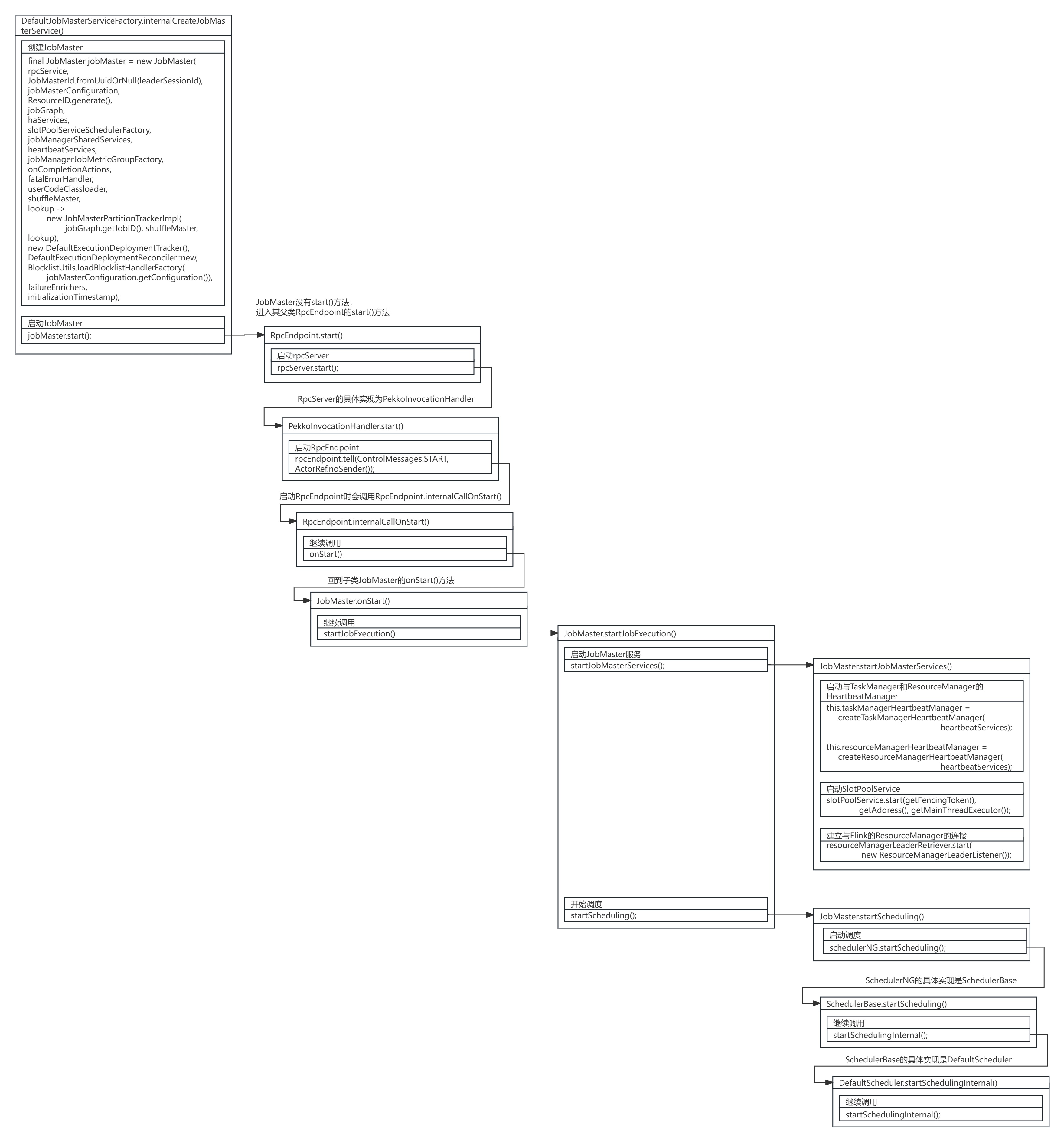
JobMaster启动经过下列一系列调用,进入JobMaster的startJobExecution()方法,开始具体JobMaster启动。
源码图解:
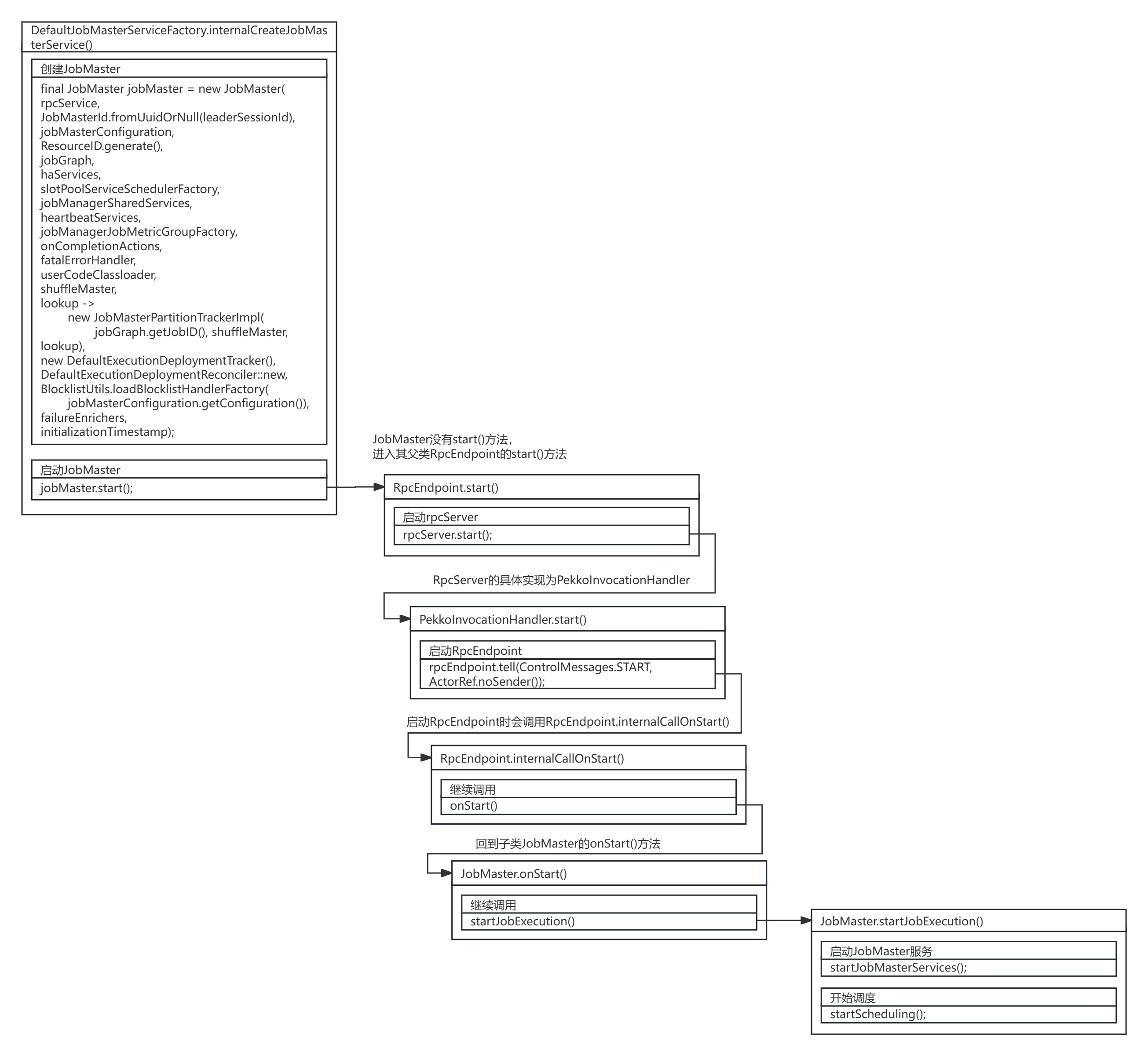
JobMaster的startJobExecution()方法启动了JobMaster服务,并开启了JobMaster调度。
JobMaster.startJobExecution()方法源码:
private void startJobExecution() throws Exception {
validateRunsInMainThread();
JobShuffleContext context = new JobShuffleContextImpl(jobGraph.getJobID(), this);
shuffleMaster.registerJob(context);
//启动JobMaster服务
startJobMasterServices();
log.info(
"Starting execution of job '{}' ({}) under job master id {}.",
jobGraph.getName(),
jobGraph.getJobID(),
getFencingToken());
//开始JobMaster调度
startScheduling();
}源码图解:
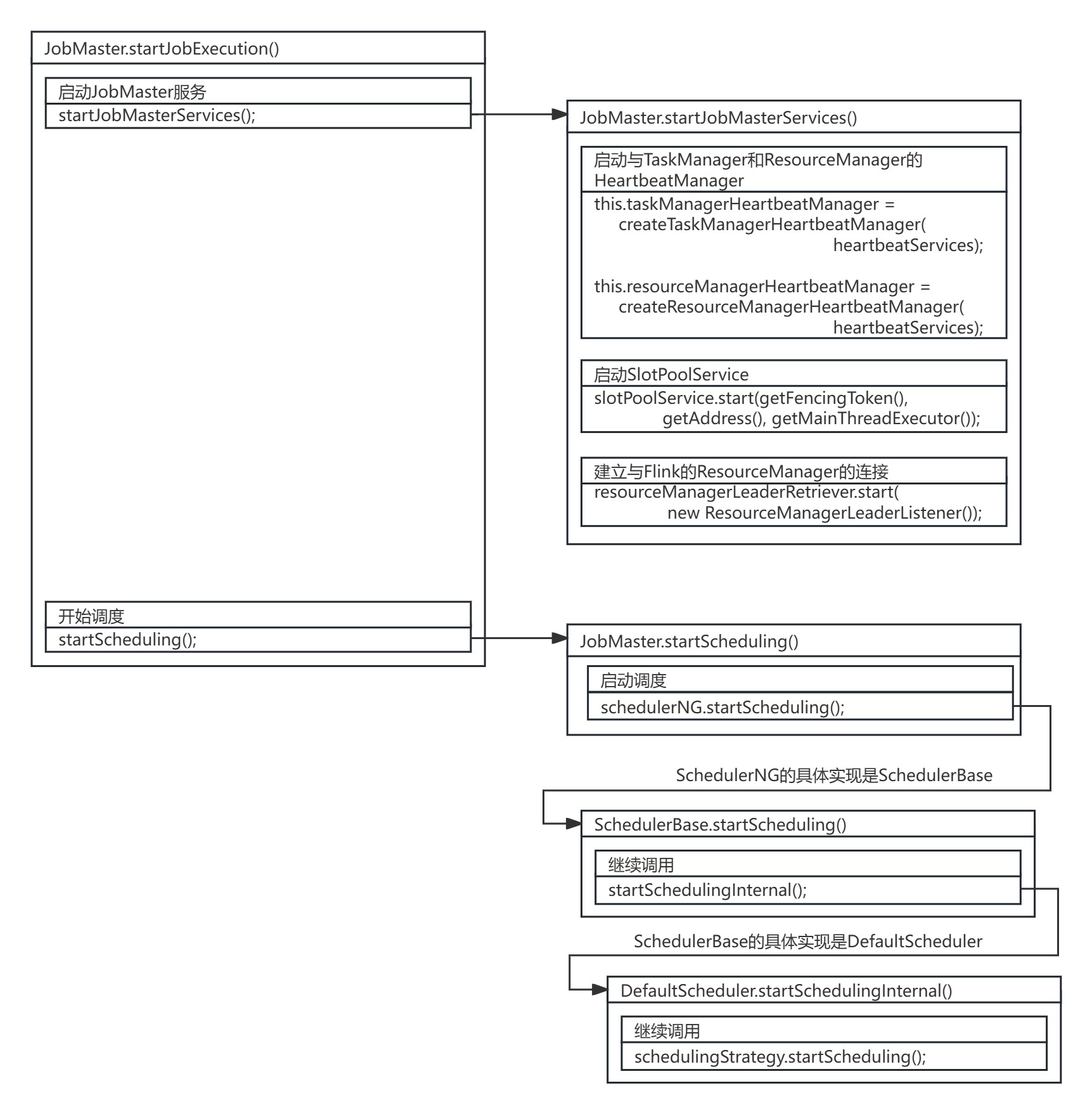
在启动JobMaster服务的JobMaster.startJobMasterServices()方法中,启动了与TaskManager和ResourceManager通信的HeartbeatManager,启动了SlotPoolService,为后续与ResourceManager交互进而申请计算资源做准备。
JobMaster.startJobMasterServices()方法源码:
private void startJobMasterServices() throws Exception {
try {
//启动与TaskManager和ResourceManager通信的HeartbeatManager
this.taskManagerHeartbeatManager = createTaskManagerHeartbeatManager(heartbeatServices);
this.resourceManagerHeartbeatManager =
createResourceManagerHeartbeatManager(heartbeatServices);
//启动SlotPoolService
// start the slot pool make sure the slot pool now accepts messages for this leader
slotPoolService.start(getFencingToken(), getAddress(), getMainThreadExecutor());
// job is ready to go, try to establish connection with resource manager
// - activate leader retrieval for the resource manager
// - on notification of the leader, the connection will be established and
// the slot pool will start requesting slots
//建立与Flink的ResourceManager的连接
resourceManagerLeaderRetriever.start(new ResourceManagerLeaderListener());
} catch (Exception e) {
handleStartJobMasterServicesError(e);
}
}在开启JobMaster调度的JobMaster.startScheduling()方法中,又经历了几次调用,最终JobMaster开启了SchedulerNG的调度。
JobMaster.startScheduling()方法源码:
private void startScheduling() {
//继续调用
schedulerNG.startScheduling();
}
继续调用,其中SchedulerNG的具体实现为SchedulerBase。
SchedulerBase.startScheduling()方法源码:
public final void startScheduling() {
mainThreadExecutor.assertRunningInMainThread();
registerJobMetrics(
jobManagerJobMetricGroup,
executionGraph,
this::getNumberOfRestarts,
deploymentStateTimeMetrics,
executionGraph::registerJobStatusListener,
executionGraph.getStatusTimestamp(JobStatus.INITIALIZING),
jobStatusMetricsSettings);
operatorCoordinatorHandler.startAllOperatorCoordinators();
//继续调用
startSchedulingInternal();
}继续调用,其中SchedulerBase的具体实现为DefaultScheduler。
DefaultScheduler.startSchedulingInternal()方法源码:
protected void startSchedulingInternal() {
log.info(
"Starting scheduling with scheduling strategy [{}]",
schedulingStrategy.getClass().getName());
transitionToRunning();
//开始调度
schedulingStrategy.startScheduling();
}最终执行到schedulingStrategy.startScheduling(),开始进行JobMaster与Flink ResourceManager通信,为Task进行cpu与内存申请的资源调度,资源调度的源码解析将在本专栏后续博文中具体展开。
至此,Flink集群端完成了Dispatcher对客户端调度请求的接收,创建并启动了JobMaster,JobMaster开始进行ExecutionGraph生成,并开始向Flink ResourceManager申请资源。
7.结语
本文解析了Flink集群Dispatcher接收了CliFrontend客户端发送的Request,从hdfs拉取JobGraph文件、Jar包和Artifacts依赖 ,创建并启动JobMaster开始Flink集群端的调度的过程,本专栏后续博文将继续展开JobMaster的ExecutionGraph生成与Flink ResourceManager进行Cpu内存计算资源调度的源码。